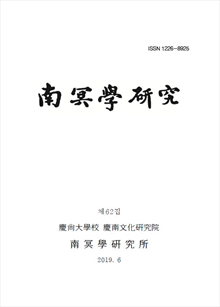간행물
남명학연구 KCI 등재 The Nammyonghak Study

- 발행기관 경상대학교 경남문화연구원
- 자료유형 학술지
- 간기 계간
- ISSN 1226-8925 (Print)
- 수록기간 1991 ~ 2019
- 주제분류 인문학 > 기타인문학 인문학 분류의 다른 간행물
- 십진분류KDC 151DDC 181
권호리스트/논문검색
제14권 (2002년 12월) 15건
1.
2002.12
서비스 종료(열람 제한)
Development of the Neo-Confucianism during the Chosen dynasty begun to get attention among international scholars since about three decade ago. Cho Sik (Nammyung, 1501-72) was one of the two most distinguished Neo-Confucian scholars at the sixteenth century with Yi Hwang (T'oegye, 1501-70). However, Cho Sik' scholarly achievements in the Neo-Confucianism had been neglected due to political reason during late Chosen dynasty. It was continued up to late 20th century.
Recently his contributions to development of Korean Neo-Confucian studies were rediscovered by new generation. His academic works written in classical Chinese had been newly translated into modern Korean and several research institutes for Nammyung studies had initiated international academic conferences on his works and their contributions to Korean intellectual community.
『 Diagram and Inscription of Shin-myung-sa』 is one of his most important works for understanding of his scholarly world-views. I have examined this work in terms of Dae-dae cultural grammar, my model of analysis on traditional Korean culture. The diagram and Inscription could be seen as the most representative summary of his life long search to understanding Sung and Ming Neo-Confucian traditions and their realization in the Chosun (Yi) dynasty. Two fundamental concepts he focused in the search are kyung and ui . In the diagram and inscription they are neatly explained how to practice in state rule and scholar's daily living. This paper shows that Dae-dae cultural grammar underlie 『 Diagram and Inscription of Shin-myung-sa』consistently.
2.
2002.12
서비스 종료(열람 제한)
4.
2002.12
서비스 종료(열람 제한)
5.
2002.12
서비스 종료(열람 제한)
6.
2002.12
서비스 종료(열람 제한)
Cho Sik was a great scholar in Chosun Dynasty. He was a contemporary scholar with Lee Hwang. We can see some statements of Cho Sik in the books written by Lee Ie(Yoolgog).
It is obvious that his thoughts affected many scholars later. In addition to this, he taught many disciples some of whom became public officials, and some became civil leaders in the War named Imjinwoeran(the invasion of the Japan, 1592). His administrative thoughts are revealed in the Letters to the King(Sangso) more clearly. And so the author analyzed the Letters and classified his administrative thoughts. The findings were like these.
His administrative thoughts could be summed 4 suggestions : leadership, personnel administration, administrative ideologies(the administration for the people and Minbon/民本 thoughts), the listening of public opinion, and the timing and Hersil(虛實, formal/substantial) as criteria for policy-making.
His administrative thoughts belong to the style of Moral-training - oriented mentioned in the paper. Generally speaking, we can see that Cho-Sik emphasizes most the Moral-training of the leader and the recruitment based on that. The administration for the people and Minbon thoughts also are the ideologies for the leader. The listening of the public opinion and the criteria for policy-making wholly rely on the will of the leader. It follows that we can see that he suggested Moral-training and will of leader for the solution of the bureaucratic problems, and he rarely discussed practical systemic and institutional reforms. This seems to reflect his absence of practical experience as a public service in bureaucratic system.
Nevertheless, his thoughts affected many practitioners and scholars later. And so we need to study the relationships with them and effects on them more clearly.
7.
2002.12
서비스 종료(열람 제한)
8.
2002.12
서비스 종료(열람 제한)
This paper was written in search for the true classical scholar whom Nammyong think is preferable. In accordance with the method of the Text-linguistics, described cohesion, the author analyzed the situationality, intertextuality, and informativity which were shown in Nammyong's poems, and the results were classified into ① situation analysis, ② coherence, ③ the diagram of the synthetical structure, and ④ translation of the poems.
The contents were arranged into two parts : ① the desertion of human desires and ② the harmony with the nature and the pleasure of hermit life. The poems and the analysed contents were like these:
The themes of 'the desertion of human desires' and 'the harmony with the nature and the pleasure of hermit life' are different, but they are of the same category. This is because the heavenly morals is conserved when the human desires are abandoned, and the harmony with the nature and the pleasure of human morality can be obtained when the heavenly morals are conserved.
Nammyong worried for the classical scholars not to cut off the human desires and to flatter themselves in search for the bureaucratic office. He said, if he became dirty because of the human desires, "He would instantly cut open the stomach, take out the dirty things, and flow down them into the river." And also he tried to put these beliefs into practice. He always carried with himself the letters of ‘Piety(敬) and Righteousness(義)', and tried to be pious internally and to be righteous externally. And so Nammyong could succeed in obtaining the harmony with the nature, and could enjoy the pleasure of hermit life.
9.
2002.12
서비스 종료(열람 제한)
10.
2002.12
서비스 종료(열람 제한)
The Ministry of Education announced the final decision of Educational Basic-Chinese-Characters by changing 44 characters from the existing 1800 characters. There could be a controversy on this subject, however careful they chose, if they put a limitation with the number of character when they made a choice Basie-Chinese-Characters.
In this paper, I'd like to tell you we must to select basic graphemes for solving that controversy with choosing Basic-Chinese-Character. For thes work, I analyzed the part of meaning and sound with 1800 characters which already were selected, of letter numbers, could be brought to a settlement through the process that extracted graphemes joined together again.
I hope this study could be helpful for choosing basic graphemes through working of extracting graphemes.

